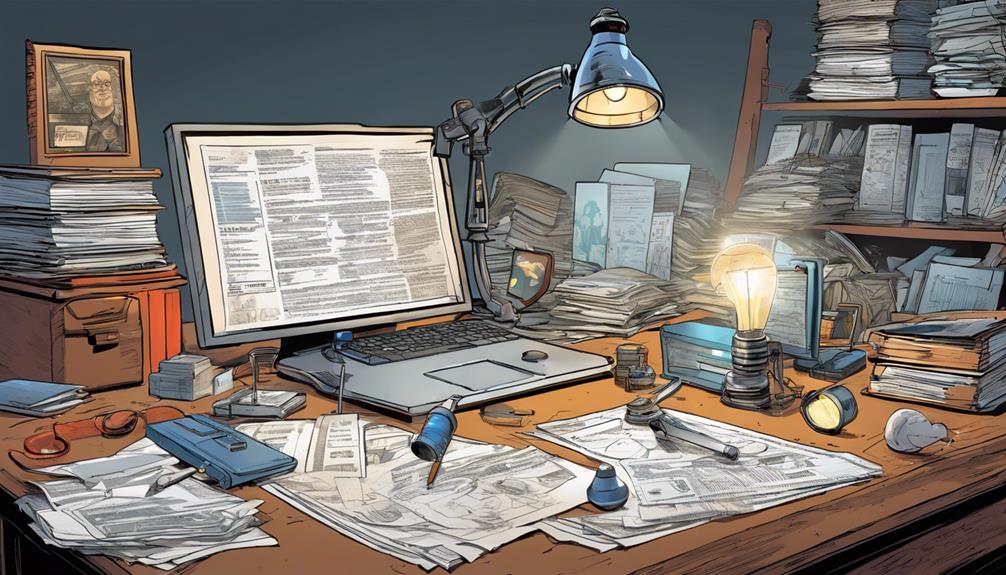You can achieve your dream of inventing today by taking actionable steps. Begin by writing down your ideas in a journal. Conduct thorough research to ensure that your invention stands out in the market. Developing a prototype will allow you to visualize your concept, while navigating through the patent process will protect your invention. Remember to create a strong marketing strategy to effectively reach your target audience. Embrace resilience and maintain a healthy work-life balance as you progress on your journey. Each of these steps lays the groundwork for success, and there is plenty more to explore in order to bring your vision to life.
Key Takeaways
- Document your invention journey meticulously in a bound journal to establish proof of conception and idea development.
- Conduct thorough research, including patent and market analysis, to assess the viability and uniqueness of your invention.
- Create a prototype to visualize and test your idea, ensuring functionality and usability before moving forward.
- Navigate the patent process with professional assistance to protect your intellectual property and secure your invention rights.
Document Your Invention Journey

To successfully navigate your invention journey, start by meticulously documenting every idea and development in an inventor's journal. This journal serves as proof of conception, ensuring you have a detailed record when you need it most.
Use a bound notebook or a specialized inventor's journal, and number each page for easy reference. Avoid unreliable methods like mailing your ideas to yourself; they won't hold up in legal situations. For extra verification, consider having a witness sign your journal entries.
Conduct Thorough Research

Conducting thorough research is essential to guarantee your invention stands out in a competitive market.
Start with an initial patent search at www.uspto.gov to avoid infringing on existing patents.
Next, perform a non-patent prior art search to uncover related designs or concepts.
Assess the market demand for your invention; remember, over 95% of patents fail to generate profit.
You should also analyze manufacturing and distribution costs to confirm your invention can be priced reasonably.
Evaluate your competition to understand their strengths and weaknesses, which will help you position your product effectively.
Finally, stay informed about industry trends to adapt your invention accordingly.
This groundwork will set you up for success as you move forward.
Create a Prototype

Creating a prototype is an essential step that transforms your invention idea into a tangible product. This process helps you visualize and refine your concept, making it easier to communicate with potential investors or partners.
Here's how to get started:
- Sketch Your Design: Begin with drawings to clarify your invention's features and functionality.
- Build a Mockup: Use accessible materials to create a basic 3-D representation of your idea.
- Develop a Working Model: Once satisfied with the mockup, create a functional prototype to test usability.
- Explore Resources: Utilize books or online kits for guidance on prototype creation, or consider computer-animated models for complex designs.
Navigate the Patent Process

After developing your prototype, the next step involves steering through the patent process to protect your invention and secure your intellectual property rights.
Start by determining whether you need a utility patent for processes or a design patent for ornamental aspects.
It's wise to consult a patent attorney or agent who can guide you through the complexities.
Gather all necessary documentation, including your inventor's journal and prototype details, to strengthen your application.
Conduct a patent search at the USPTO website to verify your invention is unique.
Develop a Marketing Strategy

To successfully bring your invention to market, you need a well-defined marketing strategy that outlines how you'll attract customers and generate sales.
Start by identifying your target audience and understanding their needs. Then, create a unique value proposition that sets your invention apart from competitors.
Here are key elements to include in your marketing strategy:
- Market Research: Analyze competitors and trends to position your invention effectively.
- Branding: Develop a memorable brand name, logo, and packaging that resonate with customers.
- Promotion: Utilize social media, online advertising, and public relations to generate buzz.
- Sales Channels: Decide whether to sell directly, through retailers, or online platforms to maximize reach.
Learn From Young Innovators

While many young innovators are making waves in the entrepreneurial world, their journeys offer invaluable lessons that can inspire your own invention dreams.
Take cues from trailblazers like Austin Russell, who became a billionaire by embracing technology and taking risks. These young visionaries often challenge norms, proving that age isn't a barrier to success.
They've mastered the art of pivoting quickly, adapting their ideas based on market feedback. You should also focus on building a strong support network and seeking mentorship, as collaboration can spark creativity.
Embrace Psychological Resilience

Embracing psychological resilience is essential for maneuvering the ups and downs of your invention journey. You'll face challenges and setbacks, but your ability to bounce back can make all the difference.
Here are some strategies to enhance your resilience:
- Cultivate a Growth Mindset: View challenges as opportunities for learning rather than failures.
- Practice Self-Compassion: Be kind to yourself during tough times; recognize that everyone struggles.
- Build a Support Network: Surround yourself with mentors and peers who encourage and uplift you.
- Set Realistic Goals: Break down your vision into achievable milestones to maintain motivation and momentum.
Prioritize Health and Well-Being

Prioritizing your health and well-being is essential for sustaining the energy and focus needed throughout your invention journey. To thrive, cultivate healthy habits like regular exercise and balanced nutrition; they'll boost your decision-making and creativity.
Schedule breaks to recharge your mind and body, preventing burnout. Embrace mindfulness practices, such as meditation or deep breathing, to reduce stress and enhance concentration.
Don't forget about sleep—adequate rest is vital for maintaining your productivity. Finally, establish a work-life balance; dedicate time for hobbies and socializing to keep your spirits high.
Frequently Asked Questions
How Do I Find Funding for My Invention Project?
To find funding for your invention project, explore crowdfunding platforms, apply for grants, network with investors, and consider pitching to venture capitalists. Be prepared with a solid business plan and a clear vision for your invention.
What Are the Common Mistakes to Avoid During Invention Development?
During invention development, avoid neglecting thorough documentation, skipping market research, underestimating costs, and rushing prototype creation. Don't overlook patent filing details or underestimate marketing efforts; each step is essential for your invention's success.
How Can I Protect My Idea Before Getting a Patent?
Like a fortress guarding treasure, you can protect your idea by documenting it meticulously in an inventor's journal, conducting patent searches, and discussing it only with trusted individuals until you secure a patent.
What Are the Costs Associated With Bringing an Invention to Market?
Bringing your invention to market involves costs like patent fees, prototype development, manufacturing, and marketing. You'll need to budget for these expenses, as they can add up quickly. Careful planning helps manage your financial investment effectively.
How Do I Choose the Right Patent Attorney for My Needs?
Choosing a patent attorney isn't just about fancy degrees; it's like picking a dance partner. You want someone who understands your moves, communicates well, and can navigate the legal floor without stepping on your toes.
What Are Some Practical Steps to Turn Invention Ideas Into Real Prototypes?
To transform ideas into prototypes, start by conducting thorough research to identify potential competitors and gather inspiration. Next, create detailed sketches or digital renderings of your invention. Then, seek feedback and make necessary revisions. Finally, seek out a skilled prototyping company to bring your concept to life.
Conclusion
As you stand on the brink of your invention journey, remember that each step brings you closer to turning your dream into reality.
The challenges may seem overwhelming, but with determination and creativity, you'll uncover solutions you never imagined.
What breakthrough will you achieve next? With each decision, you're shaping your future and potentially changing the world.
So, take a deep breath, trust the process, and step boldly into the unknown—your invention awaits!









